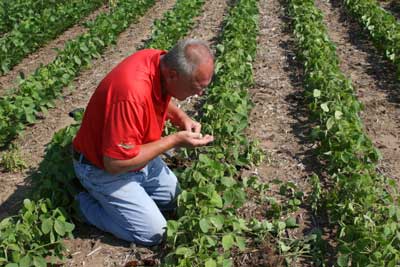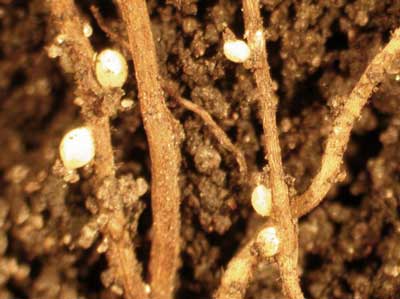
SCN Damage and Symptoms
The soybean cyst nematode (SCN), Heterodera glycines, causes greater losses than any other soybean pathogen in the U.S., with annual yield losses estimated at more than $1 billion. Yield losses can vary from year to year and are influenced by soybean variety, weather conditions, soil type and other plant stressors. SCN damage soybeans by interfering with root growth and consequently disrupting water and nutrient uptake, nodulation and nitrogen fixation and soybean growth. SCN can also cause indirect damage to soybeans by making the roots more susceptible to secondary infection by other fungal pathogens, like sudden death syndrome. Symptoms are not always visible and infections can go undetected for several years. When present, symptoms of SCN often include stunting and yellowing of the crop. However these symptoms are not diagnostic as they can also be associated with other pests, pathogens, drought or excess water, nutrient deficiencies etc. For these reasons, it is important to learn how to properly sample, identify and manage SCN.
Sampling
Plant roots can be examined for the presence of cysts or females. A good time for this sampling is about 5 weeks after planting (Pic. 1). Plants need to be gently dug to preserve the cysts and the roots can be gently rinsed with water to remove the soil and reveal the cysts (Pic. 2). However because we are at the end of the growing season I will concentrate this section of the article on soil sampling; a quantitative method to asses nematode counts in the field.
Soil sampling is necessary for estimating numbers of nematodes and diagnosing the extent of the damage. Most diagnostic programs use the egg stage for diagnosis and prediction of crop loss. In general, soybean yields decline as the number of SCN eggs increase. The higher the egg numbers, the more likelihood for root growth to be affected. Eggs are contained within the cyst, the lemon-shaped mature female, overwinter and begin hatching in the spring. One cyst may contain up to 400 eggs that can remain viable for 12 years or more.
Although SCN can be found at any time of the year as long as the soil is not too wet or too dry or frozen, fall is usually the best time for sampling. Sample after fall harvest but before tilling the ground. Each sample should be a composite of 20-30 cores 8-10” deep, taken in a zigzag pattern across the field. For large fields, collect samples from at least two random 5-acre sections with similar soils and history. Collect soil cores from underneath the crop row if soybeans were grown this season. Put the samples in a plastic bag and mail the samples to a reliable lab for analysis. The lab report will indicate the number of eggs found/ “X” volume of soil and whether you are at risk for SCN infestations so that you can implement appropriate management tools the following season.
Management
Remember that SCN can be managed, but not eradicated. The goals for managing SCN include the reduction of SCN infestation levels so as to improve soybean yields. Management practices include:
- Host resistance: SCN densities tend to decrease when resistant varieties are grown because SCN is unable to feed and develop on their roots.
- Rotation to nonhost crops: SCN numbers will decline when nonhost crops are grown as SCN is unable to develop and reproduce in the absence of host roots.
- Cultural: Adequate moisture, fertility and proper weed control will optimize plant health, increase stress tolerance and limit yield loss.
- Nematicides: some seed treatment products are labeled against SCN. They help protect the roots from SCN damage, may have activity on SCN feeding and reproduction, protect against SCN-related diseases and provide yield protection.

Picture 1: Soybean Cyst nematode sampling in roots a few weeks after planting (Source: GROWMARK, Inc.)
Picture 2: Soybean cyst nematode on soybean roots (Source: GROWMARK, Inc.)